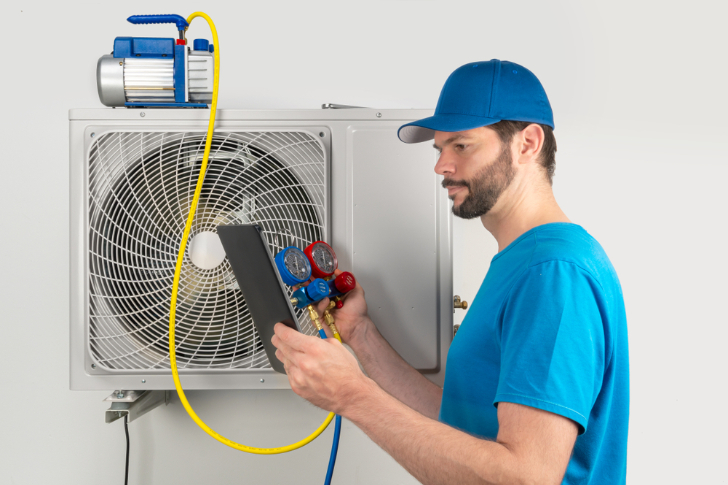The United States, with its diverse climates ranging from the sweltering summers of the South to the frigid winters of the North, relies heavily on efficient and reliable Heating, Ventilation, and Air Conditioning (HVAC) systems. These systems are not just about comfort; they are crucial for health, safety, and productivity in homes and businesses across the nation. The HVAC service industry in the USA is a vast and essential sector, providing a wide spectrum of expertise to ensure Americans remain comfortable indoors, no matter the weather outside.

The Vital Role of HVAC Services in the USA
HVAC services in the USA extend beyond simply fixing a broken air conditioner or furnace. They are critical for:
- Maintaining Comfortable Indoor Temperatures: Providing heating in the winter and cooling in the summer to ensure a livable and productive environment.
- Ensuring Air Quality: Filtering out pollutants, allergens, and humidity to create a healthy indoor atmosphere.
- Energy Efficiency: Optimizing HVAC system performance to reduce energy consumption and lower utility bills, a significant concern for many American households and businesses.
- Safety: Preventing hazards associated with faulty heating systems, such as carbon monoxide leaks, and ensuring the safe operation of cooling systems.
- Preventing Costly Repairs: Regular maintenance can identify and address minor issues before they escalate into major, expensive problems.
- Extending System Lifespan: Proper care and maintenance can significantly prolong the life of an HVAC system, protecting the initial investment.
- Compliance with Regulations: Adhering to federal, state, and local regulations regarding energy efficiency and environmental standards.
Exploring the Diverse Range of HVAC Services
The HVAC service industry in the USA offers a comprehensive array of services to meet the varied needs of its population:
- HVAC Repair: Addressing malfunctions in heating and cooling systems, including issues with compressors, fans, motors, coils, thermostats, and ductwork. Prompt and efficient repair is crucial to restore comfort and prevent further damage.
- HVAC Installation: Installing new heating, ventilation, and air conditioning systems in residential and commercial buildings, ensuring proper sizing, efficiency, and adherence to building codes. This includes central AC units, furnaces, heat pumps, ductless mini-splits, and more.
- HVAC Maintenance: Providing routine check-ups, cleaning, and tune-ups of HVAC systems to ensure optimal performance, energy efficiency, and longevity. Regular maintenance typically includes filter replacement, coil cleaning, system checks, and lubrication of moving parts.
- Duct Cleaning and Repair: Cleaning air ducts to remove dust, allergens, and other pollutants, improving air quality and system efficiency. Repairing damaged or leaking ductwork to prevent energy loss.
- Refrigerant Services: Handling refrigerant leaks, recharging refrigerant levels, and ensuring proper disposal of refrigerants in accordance with environmental regulations.
- Thermostat Services: Installing, repairing, and upgrading thermostats, including smart thermostats that offer enhanced control and energy savings.
- Emergency HVAC Services: Providing 24/7 support for urgent heating or cooling issues, particularly during extreme weather conditions.
- Indoor Air Quality Services: Offering solutions to improve indoor air quality, such as air purifiers, humidifiers, dehumidifiers, and UV-C light systems.
- Energy Audits and System Upgrades: Assessing the energy efficiency of existing HVAC systems and recommending upgrades to more efficient models to reduce energy consumption and costs.
- Commercial HVAC Services: Providing specialized HVAC solutions for commercial buildings, including large-scale system installation, maintenance, and repair.
Factors Influencing the Cost of HVAC Services in the USA
The cost of HVAC services in the USA can vary considerably based on numerous factors:
- Type of Service: Routine maintenance is generally less expensive than complex repairs or full system replacements. Emergency services often incur higher costs due to after-hours or weekend rates.
- Complexity of the Issue: Simple repairs, like replacing a capacitor, will cost less than major repairs, such as replacing a compressor or heat exchanger.
- Type and Size of HVAC System: Different types of HVAC systems (e.g., central AC, heat pump, furnace, ductless mini-split) have varying parts and complexities, affecting repair and maintenance costs. Larger systems typically require more time and resources.
- Brand and Model of Equipment: High-end or specialized brands may have more expensive parts and require technicians with specific expertise.
- Labor Costs: Labor rates for HVAC technicians vary significantly across different regions and even within the same state, influenced by factors like the cost of living and demand for services.
- Travel and Service Call Fees: Many HVAC companies charge a service call fee to cover the cost of dispatching a technician to your location. This fee may or may not be applied towards the cost of the repair.
- Parts Costs: The cost of replacement parts can vary widely depending on the specific component and its availability.
- Time of Day and Day of the Week: Services performed outside of regular business hours (nights, weekends, holidays) often come with premium rates.
- Location: Urban areas and regions with higher costs of living generally have higher HVAC service costs.
- Warranty Coverage: If the HVAC system is under warranty, some or all of the repair or replacement costs may be covered.
Table 1: Estimated Costing for Common Residential HVAC Services in the USA (National Averages)
| Service Type | Average Cost Range (USD) | Notes |
|---|---|---|
| HVAC System Tune-Up/Maintenance | $75 – $200 per visit | Typically includes inspection, cleaning, and minor adjustments. Annual maintenance is recommended. |
| AC Repair (Minor – e.g., capacitor replacement) | $100 – $400 | Cost varies based on the specific part and labor. |
| AC Repair (Major – e.g., compressor replacement) | $800 – $3,000+ | One of the most expensive AC repairs. |
| Furnace Repair (Minor – e.g., ignitor replacement) | $150 – $300 | Cost varies based on the specific part and labor. |
| Furnace Repair (Major – e.g., heat exchanger replacement) | $500 – $1,500+ | Can sometimes be more cost-effective to replace the entire unit. |
| Thermostat Replacement | $100 – $350 | Includes basic to smart thermostats. |
| Duct Cleaning | $250 – $1,000+ | Depends on the size and complexity of the ductwork. |
| Emergency Service Call | $150 – $300+ (plus repair costs) | Higher rates for after-hours or weekend service. |
Note: These are national averages and actual costs in Surat, Gujarat, India, would be significantly different due to varying labor rates, material costs, and market conditions. This table is for understanding costs within the USA context.
Table 2: Estimated Costing for HVAC System Replacement in the USA (National Averages, Including Installation)
| System Type | Average Cost Range (USD) | Notes |
|---|---|---|
| Central Air Conditioner Replacement | $3,800 – $7,500 | Depends on size, efficiency, and brand. |
| Furnace Replacement (Gas) | $2,600 – $6,200 | Depends on size, efficiency, and brand. |
| Furnace Replacement (Electric) | $750 – $3,500 | Generally less expensive than gas furnaces for replacement. |
| Heat Pump Replacement | $2,900 – $7,500 | Can vary based on type (air-source, geothermal) and efficiency. |
| Ductless Mini-Split Installation (Single Zone) | $2,000 – $5,000 | Cost increases with more zones. |
| Complete HVAC System Replacement (AC & Furnace) | $5,000 – $12,000+ | Depends on the combination of units and complexity. |
Note: These are national averages and actual costs in Surat, Gujarat, India, would be significantly different. This table is for understanding costs within the USA context.
Choosing the Right HVAC Service Provider in the USA
Selecting a qualified and reputable HVAC service provider is crucial for ensuring quality work and fair pricing. Consider the following:
Local Knowledge: A local HVAC company will be familiar with the specific climate challenges and building codes in your area.
Licensing and Insurance: Verify that the company and its technicians are properly licensed and insured.
Experience and Reputation: Look for companies with a long history of service and positive customer reviews. Check online review platforms and ask for references.
Certifications: Look for certifications from industry-recognized organizations like NATE (North American Technician Excellence).
Written Estimates: Obtain detailed written estimates before any work begins, outlining the scope of work, materials, and labor costs.
Guarantees and Warranties: Inquire about warranties on parts and labor.
Emergency Service Availability: If 24/7 emergency service is important to you, confirm that the company offers it.
Energy Efficiency Expertise: If you are interested in upgrading to more energy-efficient systems, choose a contractor with expertise in this area.











